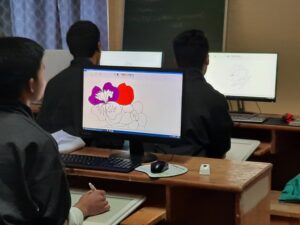


Patra, the art of wood carving, is an essential part of Bhutanese architecture and lifestyle and one of the Zorig Chusum (13 traditional arts and crafts). It is an art that has been perfected and past down from generations to generations and an integral piece of traditional Bhutanese architecture and applied everywhere, from interiors of dzongs and monasteries to furniture decoration in ordinary households.
Patra students learn the intricate art of Carving but in CTAS, they also have to undergo the basics of drawing and painting rimo so that they can work independently and not have to rely on other people to do the initial drawings and the finishing paint.

Lhadi Level One students learn to draw simple drawings of symbols like patra zheten rimo, luroe (dangpa, ngepa & sumpa), goendriem, choezay rimo and tashi dagay (the Eight Lucky Signs).
Lhadi Level One are taught how to mix basic colors using sa tshoen (mud paint), zang tshoen (copper paint) and waterproof paint. They are also taught how to do simple paintings of symbols and flowers like sew meto pem, kaba meto, norbu gongkhay and ting (clouds). Students also get to try painting rabsey (traditional Bhutanese house painting design) like kaba, tenkhep, ngap, tenkha, janachari on canvas.
Patra Level Two students are taught how to draw Zhugngyen rimo (drawing body parts of living beings). They learn how to draw the lokhor chuni (the twelve zodiac animals), the Four Powerful animals (Ta, Sing, Chung, Druk) and the Tshepatra (Mythical cat).
Patra Level Two students are taught how to carve the Eight Lucky signs, the Four Powerful animals, and the Royal Emblem of Bhutan. Each month, a week is allocated for painting class to paint on the carved product.
Patra Level Three students are taught to draw the Thunpapunzhi (the Four Harmonious Friends) cherbu with chatshang and redha choekhor (two deer with the wheel of dharma).
Patra Level Three students are taught to carve Zhugngyen patra, like Tshepatra (mythical cat), Thunpapunzhi, Redhachokor, Jatshering (phoenix), Tshering namdru, and thrie with intricate designs.
Patra Level Four students are taught to draw tshering dolkhor cherbu, namzha dhub and namzha chachang. At this level, students have attained the necessary skills and knowledge of drawing required for Patra so the main focus is on the Carving portion of curriculum.
Patra Level Three students are taught to learn to carve the Four Powerful Animals, thrie and chodrom (throne and table) with intricate designs such as the Namsay/chobi lham chodrom and thothrie, and the lungta (wind horse).
Patra Level Five is considered as a professional program because it is a transitional period from school to the real world. Students are introduced to the job market by school alumni and get advice from alumnus who have already gained significant knowledge about doing Patra in the real world.

Patra students are required to complete six-ten weeks of On the Job Training (OJT), a period of internship that offers students practical experience.
In order to get promoted to next level, students are assessed on a monthly basis and have to clear the exam. Students are expected to take exams twice a year, in July and in December. By the end of the year, the students are expected to draw rimo accurately from memory, make their own blue print designs, understand the sequence of painting and paint as per the requirements.
Students are expected to have mastered carving and have full understanding with its meaning and significance. In order to get the degree certificate the student are assessed on the hardship basis of their work and have to clear the exam successfully.

Students learn basic computer skills such as typing, creating slides, using the internet as a resource and basic graphic design. The program was introduced in 2012 with the objective to provide basic IT knowledge.

Students learn simple Dzongkha with the basic skills of reading and writing in Dzongkha. Since Dzongkha is a key aspect of our culture, students are taught Dzongkha to enrich their craft and learning experience.

Students learn simple English with the basic skills of reading, writing, listening and speaking in English. They learn to comprehend simple texts and hold conversations in english.

Students learn simple math skills like adding, subtracting, multiplying and dividing numbers to solve problems. They also learn basic formulas and equations.
To provide students with the opportunity to explore various crafts and discover their individual inclinations, enabling them to make informed decisions about their chosen field of study, the school has introduced foundation classes in three new crafts starting 2025.
This initiative not only allows students to gain hands-on experience in different artistic disciplines but also provides an opportunity for those who did not qualify in the selection interview to develop their skills. Based on their performance, they may be enrolled in their chosen program the following year, ensuring that passionate learners get the chance to pursue their artistic aspirations.




© Choki Traditional Art School. All rights reserved 2021